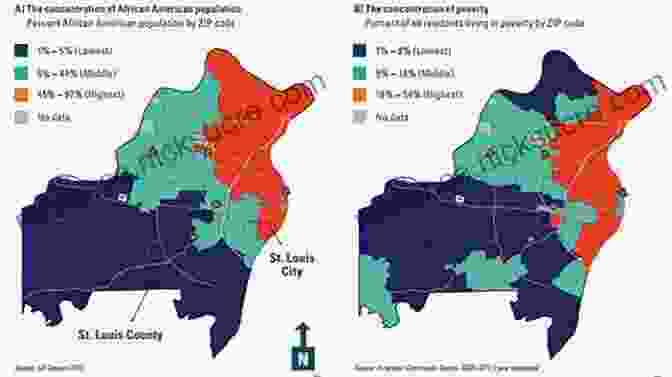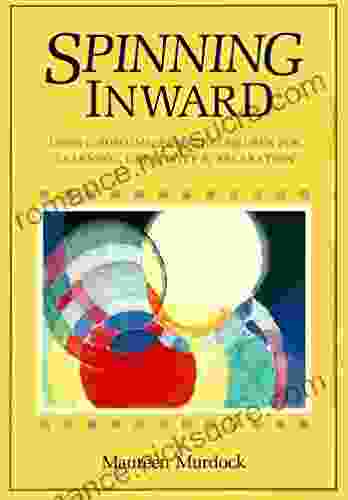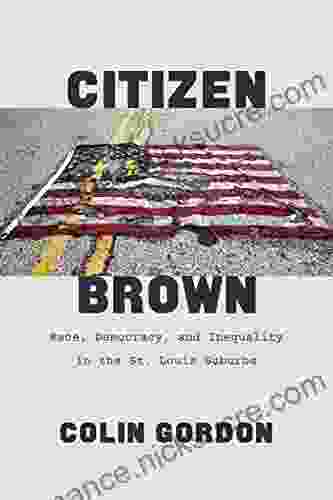Race, Democracy, and Inequality in the St. Louis Suburbs: A Long Tail of Disparities


The St. Louis suburbs are a microcosm of the racial and economic disparities that plague the United States. While the region has made progress in recent decades, significant challenges remain. This article explores the history of race and democracy in the St. Louis suburbs, examining the root causes of inequality and offering solutions to address these challenges.
4.5 out of 5
| Language | : | English |
| File size | : | 5866 KB |
| Text-to-Speech | : | Enabled |
| Screen Reader | : | Supported |
| Enhanced typesetting | : | Enabled |
| Word Wise | : | Enabled |
| Print length | : | 210 pages |
| Lending | : | Enabled |
A History of Racial Division
The St. Louis suburbs were founded on a foundation of racial segregation. In the early 20th century, white residents fled the city of St. Louis to escape the growing black population. They established all-white suburbs, often through restrictive covenants that prohibited the sale of homes to black families. This pattern of segregation continued for decades, creating a patchwork of racially homogeneous communities.
The legacy of this segregation is still visible today. The St. Louis suburbs remain some of the most segregated in the country. Black residents are more likely to live in poverty, have lower incomes, and experience higher rates of crime and unemployment than white residents. They are also less likely to have access to quality education, healthcare, and other essential services.
The Impact of White Flight
One of the most significant factors contributing to inequality in the St. Louis suburbs is white flight. In the decades following World War II, white residents began to flee the city of St. Louis in large numbers. This exodus was driven by a number of factors, including fear of crime, declining property values, and the growing black population.
White flight had a devastating impact on the city of St. Louis. It led to a loss of tax revenue, a decline in property values, and a decrease in the quality of public services. It also created a more racially segregated city, with black residents concentrated in the city's poorest neighborhoods.
The Rise of the Suburbs
As white residents fled the city, they settled in the suburbs, where they found more affordable housing, better schools, and lower crime rates. The suburbs became havens for white families, who were able to enjoy a higher quality of life than their urban counterparts.
However, the suburbs were not immune to the problems of racial inequality. Even though they were predominantly white, the suburbs still had a significant black population. Black residents in the suburbs often faced discrimination in housing, employment, and education. They also had less access to quality public services than white residents.
The Long Tail of Disparities
The disparities between black and white residents in the St. Louis suburbs are not simply a matter of history. They are a persistent problem that continues to affect the region today. The long tail of disparities is the result of a number of factors, including:
*
- Residential segregation: The St. Louis suburbs remain highly segregated, with black residents more likely to live in poverty-stricken neighborhoods with high crime rates and low-quality schools.
- Racial discrimination: Black residents in the suburbs continue to face discrimination in housing, employment, and education. They are also more likely to be stopped by the police and subjected to excessive force.
- Lack of investment: The St. Louis suburbs have historically underinvested in black neighborhoods. This has led to a lack of affordable housing, quality schools, and other essential services.
Solutions to Address Inequality
The long tail of disparities in the St. Louis suburbs is a complex problem that requires a comprehensive solution. There is no single solution that will address all of the challenges facing the region. However, there are a number of steps that can be taken to reduce inequality and create a more just and equitable society.
One of the most important steps is to address the underlying causes of inequality. This includes tackling racial discrimination, investing in black neighborhoods, and providing equal access to quality education, healthcare, and other essential services.
It is also important to challenge the narrative of the St. Louis suburbs as a haven for white families. The suburbs are home to a significant black population that faces many of the same challenges as black residents in the city of St. Louis. By acknowledging the experiences of black suburban residents, we can begin to address the long tail of disparities that they face.
The St. Louis suburbs are a microcosm of the racial and economic disparities that plague the United States. While the region has made progress in recent decades, significant challenges remain. The long tail of disparities is a result of a number of factors, including residential segregation, racial discrimination, and lack of investment. To address these challenges, we must challenge the narrative of the St. Louis suburbs as a haven for white families, acknowledge the experiences of black suburban residents, and invest in policies that promote racial equity.
4.5 out of 5
| Language | : | English |
| File size | : | 5866 KB |
| Text-to-Speech | : | Enabled |
| Screen Reader | : | Supported |
| Enhanced typesetting | : | Enabled |
| Word Wise | : | Enabled |
| Print length | : | 210 pages |
| Lending | : | Enabled |
Do you want to contribute by writing guest posts on this blog?
Please contact us and send us a resume of previous articles that you have written.
 Fiction
Fiction Non Fiction
Non Fiction Romance
Romance Mystery
Mystery Thriller
Thriller SciFi
SciFi Fantasy
Fantasy Horror
Horror Biography
Biography Selfhelp
Selfhelp Business
Business History
History Classics
Classics Poetry
Poetry Childrens
Childrens Young Adult
Young Adult Educational
Educational Cooking
Cooking Travel
Travel Lifestyle
Lifestyle Spirituality
Spirituality Health
Health Fitness
Fitness Technology
Technology Science
Science Arts
Arts Crafts
Crafts DIY
DIY Gardening
Gardening Petcare
Petcare Katherine Roberts
Katherine Roberts Rick Monday
Rick Monday Jonathan Malesic
Jonathan Malesic William P Berlinghoff
William P Berlinghoff Mercedes Kirkel
Mercedes Kirkel Mariamelys Yanez
Mariamelys Yanez James Weldon Johnson
James Weldon Johnson Albert Einstein
Albert Einstein Meg Jay
Meg Jay Robert Yang
Robert Yang Carlos Magdalena
Carlos Magdalena Janet Evans
Janet Evans Ken Blanchard
Ken Blanchard John Richardson
John Richardson Ruth F Craven
Ruth F Craven Samuel Garcia
Samuel Garcia Rachel Russ
Rachel Russ Confident Golfer
Confident Golfer Linda E Mccuistion
Linda E Mccuistion Wayne Evans
Wayne Evans Katie Mangelsdorf
Katie Mangelsdorf Charles Soule
Charles Soule Michael Walker
Michael Walker Rich Dossan
Rich Dossan Lynn Mann
Lynn Mann Maggie Dallen
Maggie Dallen Julie Taylor
Julie Taylor Gretchen Reynolds
Gretchen Reynolds Patrick Vinton Kirch
Patrick Vinton Kirch Nick O Hern
Nick O Hern Clementine Paddleford
Clementine Paddleford Stephanie Clarke
Stephanie Clarke Dr Smita Malhotra
Dr Smita Malhotra Michael A Tompkins
Michael A Tompkins Tom Callahan
Tom Callahan Nicola Yoon
Nicola Yoon Kirk White
Kirk White Lilia Tarawa
Lilia Tarawa John D Gordon
John D Gordon Donna Williams
Donna Williams Nancy L Carr
Nancy L Carr Patrick F Mcmanus
Patrick F Mcmanus Donna Shaw
Donna Shaw Pat Harvey
Pat Harvey Jeffrey Hoffstein
Jeffrey Hoffstein Randy Woodley
Randy Woodley Eknath Easwaran
Eknath Easwaran Danielle Keil
Danielle Keil Linda Gassenheimer
Linda Gassenheimer Nystce Exam Secrets Test Prep Team
Nystce Exam Secrets Test Prep Team Mark S Kinzer
Mark S Kinzer Deanna Pecaski Mclennan
Deanna Pecaski Mclennan Jason Fried
Jason Fried Robin Mckinley
Robin Mckinley Joseph Lanzara
Joseph Lanzara Roman Dial
Roman Dial Melissa De La Cruz
Melissa De La Cruz Mark Levi
Mark Levi Michael R Shea
Michael R Shea Paul Tough
Paul Tough Rick Ackerly
Rick Ackerly Course Hero
Course Hero Emily Lammers
Emily Lammers Andrew Hacker
Andrew Hacker John Medina
John Medina Leslie R Schover
Leslie R Schover Mockingbird The Mincing
Mockingbird The Mincing Tony Diterlizzi
Tony Diterlizzi Martina Mcbride
Martina Mcbride Alejandro Sequera
Alejandro Sequera Tim J Wise
Tim J Wise Jeff Steiner
Jeff Steiner Diana L Paxson
Diana L Paxson Steve Raymond
Steve Raymond Mark Zegarelli
Mark Zegarelli Matthew Fox
Matthew Fox Nicholas Tomalin
Nicholas Tomalin Jacob Teitelbaum
Jacob Teitelbaum Emily M Leonard
Emily M Leonard Christine Conners
Christine Conners Hannah Fry
Hannah Fry Mike Clelland
Mike Clelland Jessica Rohrer
Jessica Rohrer Joy Goodwin
Joy Goodwin Ken Warner
Ken Warner Helen Savore
Helen Savore Francis Borceux
Francis Borceux Jon Sterngass
Jon Sterngass Scott Strother
Scott Strother Christopher G Fairburn
Christopher G Fairburn Gooseberry Patch
Gooseberry Patch Jon R Lindsay
Jon R Lindsay David Estes
David Estes Christopher Boehm
Christopher Boehm Toney Allman
Toney Allman Dr Lucie Rivera
Dr Lucie Rivera Cheikh Anta Diop
Cheikh Anta Diop Mark Stewart
Mark Stewart Oludamini Ogunnaike
Oludamini Ogunnaike Ernest Holmes
Ernest Holmes Doris Barren
Doris Barren Carmen Viktoria Gamper
Carmen Viktoria Gamper Martin Hall
Martin Hall Colin Gordon
Colin Gordon William Kennedy
William Kennedy Fred Zeglin
Fred Zeglin Dave Buscema
Dave Buscema Deirdre Pitney
Deirdre Pitney Catherine Ann Clemett
Catherine Ann Clemett Rachel Johnson Greer
Rachel Johnson Greer Russ Eanes
Russ Eanes Marilee Sprenger
Marilee Sprenger Lucy Rees
Lucy Rees Frank Zane
Frank Zane Lily Collins
Lily Collins Jamie Marich
Jamie Marich Orangepen Publications
Orangepen Publications Lauren Mcduffie
Lauren Mcduffie Sarah Hendrickx
Sarah Hendrickx Richard Dewitt
Richard Dewitt Oliver T Spedding
Oliver T Spedding Mary E Hagle
Mary E Hagle Rhythm Aida
Rhythm Aida Rachelle Zukerman
Rachelle Zukerman Monica Swanson
Monica Swanson Mike Sheridan
Mike Sheridan John Blair
John Blair Stedman Graham
Stedman Graham Helen Saul Case
Helen Saul Case Jay L Devore
Jay L Devore Candace Couch
Candace Couch Susie Allison
Susie Allison Lee Savage
Lee Savage Emily Lowry
Emily Lowry Magdalena Jackowska
Magdalena Jackowska Rick Townsend
Rick Townsend Summary Genie
Summary Genie Don Holbrook
Don Holbrook Stian Christophersen
Stian Christophersen Frederick Douglass Opie
Frederick Douglass Opie Catherine Oxenberg
Catherine Oxenberg Gabrielle Douglas
Gabrielle Douglas Judy Sierra
Judy Sierra R Philip Bouchard
R Philip Bouchard Nicholas Bjorn
Nicholas Bjorn Winslow Tudor
Winslow Tudor Clint Orr
Clint Orr Terry M Redding
Terry M Redding Cecil B Hartley
Cecil B Hartley Emma Jane Unsworth
Emma Jane Unsworth Marilyn J Hockenberry
Marilyn J Hockenberry Scott Weidensaul
Scott Weidensaul Platinum Creation
Platinum Creation Norman Thelwell
Norman Thelwell Peterson S
Peterson S Valerie Ann Worwood
Valerie Ann Worwood H Keith Melton
H Keith Melton Catherine S Gregory
Catherine S Gregory Robert Kratz
Robert Kratz Sheena Iyengar
Sheena Iyengar Carmen Davenport
Carmen Davenport Seth Godin
Seth Godin Paul Andrew Asmuth
Paul Andrew Asmuth Travis Morris
Travis Morris R F Egerton
R F Egerton Julie Johnson
Julie Johnson Joel A Rippel
Joel A Rippel James Van Praagh
James Van Praagh Charles Edward Chapel
Charles Edward Chapel Celine Clive
Celine Clive Richard Conniff
Richard Conniff Darrell Bricker
Darrell Bricker Glenn Doman
Glenn Doman Rachael Scdoris
Rachael Scdoris Kara Thomas
Kara Thomas Elizabeth Warnock Fernea
Elizabeth Warnock Fernea Jessica Berger Gross
Jessica Berger Gross Eva Maria Zurhorst
Eva Maria Zurhorst Bonnie Zieman
Bonnie Zieman Guy Fieri
Guy Fieri Ilia Blandina
Ilia Blandina Matt Landry
Matt Landry Tamara Tobias
Tamara Tobias Susan Casey
Susan Casey Christopher Ives
Christopher Ives Morton D Davis
Morton D Davis David Mcgriffy
David Mcgriffy Karen M Masterson
Karen M Masterson Shefali Tsabary
Shefali Tsabary Maureen Murdock
Maureen Murdock Gene Luen Yang
Gene Luen Yang Kenny Moore
Kenny Moore Jane E Drichta
Jane E Drichta Dan Hamilton
Dan Hamilton Sean Moloney
Sean Moloney Dan Sheeks
Dan Sheeks Sarah S Richardson
Sarah S Richardson Cathy O Neil
Cathy O Neil Richard Hasse
Richard Hasse Gary L Greenwald
Gary L Greenwald Muhammad Ali
Muhammad Ali Laurie Halse Anderson
Laurie Halse Anderson Lisha Epperson
Lisha Epperson Brandi Chastain
Brandi Chastain Reda Waaziz
Reda Waaziz Joanne Limburg
Joanne Limburg Eve Porinchak
Eve Porinchak Naomi Chunilal
Naomi Chunilal Jay Mccullough
Jay Mccullough Vincent Chidindu Asogwa
Vincent Chidindu Asogwa Rick Burgess
Rick Burgess Capers Jones
Capers Jones Graham Hancock
Graham Hancock Jason Reynolds
Jason Reynolds 1st Ed 2019 Edition Kindle Edition
1st Ed 2019 Edition Kindle Edition Nicole R Taylor
Nicole R Taylor Shea Ernshaw
Shea Ernshaw Mike Horn
Mike Horn Eriko Sato
Eriko Sato Phil Cavell
Phil Cavell Eric Mayost
Eric Mayost Abraham Flexner
Abraham Flexner Charles Frederic Chapman
Charles Frederic Chapman J K Sheindlin
J K Sheindlin Esther Joos Esteban
Esther Joos Esteban Scott Murr
Scott Murr Jenna Gensic
Jenna Gensic Pardis Mahdavi
Pardis Mahdavi Jeremy Keeshin
Jeremy Keeshin Sergey K Aityan
Sergey K Aityan Vanessa Len
Vanessa Len Pete Fromm
Pete Fromm Pamela S Turner
Pamela S Turner Gary Mccord
Gary Mccord Jennifer Ward
Jennifer Ward Jon Haws
Jon Haws Wendy Hinman
Wendy Hinman Karen J Bun
Karen J Bun Cory Mccartney
Cory Mccartney Mark Harmon
Mark Harmon Jason Scotts
Jason Scotts Maria Del Russo
Maria Del Russo Jordon Greene
Jordon Greene Dan Cryan
Dan Cryan Ken Alder
Ken Alder Yuxi Hayden Liu
Yuxi Hayden Liu Jerry Dennis
Jerry Dennis Henry E Mejia
Henry E Mejia Dr Alison Dibarto Goggin
Dr Alison Dibarto Goggin Jennifer Hallissy
Jennifer Hallissy Ravin Kumar
Ravin Kumar Reid Oslin
Reid Oslin Conrad Goeringer
Conrad Goeringer George Gamow
George Gamow Varg Freeborn
Varg Freeborn Daniel Zwillinger
Daniel Zwillinger Igor Dudukchan
Igor Dudukchan Cindy Post Senning
Cindy Post Senning David J Helfand
David J Helfand Thomas Celentano
Thomas Celentano Tomi Adeyemi
Tomi Adeyemi Walter Sosa Escudero
Walter Sosa Escudero Martin Mahner
Martin Mahner Dennis G Zill
Dennis G Zill Educational Testing Service
Educational Testing Service Carol Anderson
Carol Anderson James Lawrence Powell
James Lawrence Powell Rebecca Anne Bailey
Rebecca Anne Bailey Wendy M Reinke
Wendy M Reinke Eamon Duffy
Eamon Duffy Sam Sheridan
Sam Sheridan Lisa Kenney
Lisa Kenney Om Krishna Uprety
Om Krishna Uprety Debbie Madson
Debbie Madson John Green
John Green Michel Boivin
Michel Boivin Xiran Jay Zhao
Xiran Jay Zhao John M Taylor
John M Taylor Marc Lipson
Marc Lipson Maxim Starchenko
Maxim Starchenko Shelly Westerhausen
Shelly Westerhausen C Osvaldo Gomez
C Osvaldo Gomez Jill Boucher
Jill Boucher Marie T Banich
Marie T Banich Matt Omasta
Matt Omasta Tom Coyne
Tom Coyne Stephen Brennan
Stephen Brennan Catherine Carrigan
Catherine Carrigan Sir James Knowles
Sir James Knowles Charles H Townes
Charles H Townes Yossi Ghinsberg
Yossi Ghinsberg Paul Bellow
Paul Bellow Michael Pearl
Michael Pearl Lucy Ruddle
Lucy Ruddle Jim Ross
Jim Ross Stephen Voltz
Stephen Voltz James Cordrey
James Cordrey Robin Arzon
Robin Arzon Carolines Angels
Carolines Angels Derek J Flores R N
Derek J Flores R N Jack Whyte
Jack Whyte Mohammed Musthafa Soukath Ali
Mohammed Musthafa Soukath Ali Mark L Prophet
Mark L Prophet Phillip Hoose
Phillip Hoose Corinne Maier
Corinne Maier John Sandford
John Sandford Michael Sandler
Michael Sandler Schalk Holloway
Schalk Holloway Christopher Ryan
Christopher Ryan Steve Mcgregor
Steve Mcgregor Alex Berenson
Alex Berenson Edith Rogovin Frankel
Edith Rogovin Frankel Judy Gelman
Judy Gelman David Stanley
David Stanley Dr Richard Smith
Dr Richard Smith Cambridge Rory
Cambridge Rory Silvanus P Thompson
Silvanus P Thompson Patricia Raybon
Patricia Raybon Lauren Algeo
Lauren Algeo Guy Gavriel Kay
Guy Gavriel Kay John Durant
John Durant Chris Santella
Chris Santella Joanne Mcneil
Joanne Mcneil Juan Carlos Jc Santana
Juan Carlos Jc Santana Ellen Hopkins
Ellen Hopkins David Attenborough
David Attenborough D Levesque
D Levesque Oliver Sacks
Oliver Sacks Dominic O Brien
Dominic O Brien H L Mencken
H L Mencken Karl White
Karl White Carlos Pestana
Carlos Pestana Chester Ismay
Chester Ismay Karyn D Hall
Karyn D Hall Raymond G Miltenberger
Raymond G Miltenberger Judah Phillips
Judah Phillips Meg Cabot
Meg Cabot Ian Stewart
Ian Stewart Greg Vinall
Greg Vinall Karl A Pillemer
Karl A Pillemer Tetsu Kariya
Tetsu Kariya Kindle Edition
Kindle Edition Montana Ross
Montana Ross Jules Wake
Jules Wake E Ink Utilizer
E Ink Utilizer Diane Larsen Freeman
Diane Larsen Freeman Marcelo Gleiser
Marcelo Gleiser James Stewart
James Stewart Rachelle Doorley
Rachelle Doorley Edward Dutton
Edward Dutton Nicholas R Finamore
Nicholas R Finamore Jon Muller
Jon Muller Marc Lewis
Marc Lewis Nancy Carter Crump
Nancy Carter Crump Shari Y Manning
Shari Y Manning Ava Archer
Ava Archer Kerry Irving
Kerry Irving Lenka Peterson
Lenka Peterson Rev Cain
Rev Cain Ibram X Kendi
Ibram X Kendi Caitlin Dean
Caitlin Dean Jon Peterson
Jon Peterson Oscar Levin
Oscar Levin Baby Professor
Baby Professor Johannes Riffelmacher
Johannes Riffelmacher Suzanne Welander
Suzanne Welander Stephen Cleary
Stephen Cleary Monika Chang
Monika Chang Nicole Unice
Nicole Unice Heather Won Tesoriero
Heather Won Tesoriero Daniel G Amen
Daniel G Amen A R Vasishtha
A R Vasishtha David M Levine
David M Levine Jolene Brighten
Jolene Brighten Dena Merriam
Dena Merriam Dr Harmony
Dr Harmony Paul Trammell
Paul Trammell Mandee Heller Adler
Mandee Heller Adler Diane Ackerman
Diane Ackerman Matt Heid
Matt Heid David And Avi Epstein
David And Avi Epstein Rachel Ignotofsky
Rachel Ignotofsky Josh Kirchner
Josh Kirchner Tomoko Fuse
Tomoko Fuse Michael Bamberger
Michael Bamberger Dana Trentini
Dana Trentini Darren Levine
Darren Levine Christopher M Kelty
Christopher M Kelty Graham Uney
Graham Uney Leo Books
Leo Books Dedrick L Moone
Dedrick L Moone Robert Allans
Robert Allans Makiia Lucier
Makiia Lucier Db King
Db King Sharon Ward
Sharon Ward Monique Joiner Siedlak
Monique Joiner Siedlak Gershon Ben Keren
Gershon Ben Keren Frank Joseph
Frank Joseph Tashie Bhuiyan
Tashie Bhuiyan Zainab Jagot Ahmed
Zainab Jagot Ahmed Dr Ray Makar
Dr Ray Makar Joanna Sayago Golub
Joanna Sayago Golub John Cartwright
John Cartwright Tim Freke
Tim Freke Gary Chapman
Gary Chapman Jenn Garbee
Jenn Garbee Harold Anderson
Harold Anderson 1st Edition Kindle Edition
1st Edition Kindle Edition Steve Colgate
Steve Colgate Konstantinos Mylonas
Konstantinos Mylonas R K Davenport
R K Davenport Clyde E Fant
Clyde E Fant Rita Carter
Rita Carter Claire Lerner
Claire Lerner John Mccannon
John Mccannon Blake Healy
Blake Healy General
General Carl Miller
Carl Miller Stevan Harrell
Stevan Harrell Louise Davidson
Louise Davidson Hugh Neill
Hugh Neill Shale Turner
Shale Turner Dolly Chugh
Dolly Chugh Lee Feinswog
Lee Feinswog Megan Whalen Turner
Megan Whalen Turner Hakim Isler
Hakim Isler Pete Goss
Pete Goss Adrian Forte
Adrian Forte Gregory A Loew
Gregory A Loew Mateo Sol
Mateo Sol Tiffany Jewell
Tiffany Jewell Kaplan Test Prep
Kaplan Test Prep D Enette Larson Meyer
D Enette Larson Meyer Jeremy Laszlo
Jeremy Laszlo Ryan Pyle
Ryan Pyle Kevin Carr
Kevin Carr Mario Beauregard
Mario Beauregard Phil Bourjaily
Phil Bourjaily John Leland
John Leland Jessica Thom
Jessica Thom Tamsen Butler
Tamsen Butler Lori L Tharps
Lori L Tharps Molly Wizenberg
Molly Wizenberg Marina Umaschi Bers
Marina Umaschi Bers Jawanza Kunjufu
Jawanza Kunjufu Marguerite Mary Rigoglioso
Marguerite Mary Rigoglioso Josh Sundquist
Josh Sundquist Steve Burrows
Steve Burrows Erika Buenaflor M A J D
Erika Buenaflor M A J D David Hicks
David Hicks Robert F Devellis
Robert F Devellis Dagogo Altraide
Dagogo Altraide Michael Esser
Michael Esser Rob Iliffe
Rob Iliffe Kelly St Clare
Kelly St Clare Stephen Harrison
Stephen Harrison Sigmund Freud
Sigmund Freud Krishna Godhania
Krishna Godhania Sadie Radinsky
Sadie Radinsky Catherine Legrand
Catherine Legrand Worth Books
Worth Books Kate Chenery Tweedy
Kate Chenery Tweedy Creek Stewart
Creek Stewart Jen L Grey
Jen L Grey Patricia Irwin Johnston
Patricia Irwin Johnston Chris Jake
Chris Jake Justin M Jacobs
Justin M Jacobs Lorraine Allman
Lorraine Allman Dan Reeder
Dan Reeder Dr N Rama Chandran
Dr N Rama Chandran Lynn Lilly
Lynn Lilly Mary Jackson
Mary Jackson J Andrew Royle
J Andrew Royle Michael Whitehead
Michael Whitehead Sarah Van Gelder
Sarah Van Gelder Maryana Vollstedt
Maryana Vollstedt Katrine Engberg
Katrine Engberg Randi Minetor
Randi Minetor Deb Curtis
Deb Curtis Michael Daugherty
Michael Daugherty Lyle D Broemeling
Lyle D Broemeling S L Watson
S L Watson Jack Canfield
Jack Canfield Lane Pederson
Lane Pederson Nicole Santiago
Nicole Santiago Danya Kukafka
Danya Kukafka Kenneth P Langer
Kenneth P Langer Sarah Marquis
Sarah Marquis Yana Cortlund
Yana Cortlund Nadia Durrani
Nadia Durrani Morgan Rice
Morgan Rice
Light bulbAdvertise smarter! Our strategic ad space ensures maximum exposure. Reserve your spot today!

 Isaiah PowellIn Spy Search and Find the Odd One Out: A Comprehensive Guide to Unraveling...
Isaiah PowellIn Spy Search and Find the Odd One Out: A Comprehensive Guide to Unraveling... Dominic SimmonsFollow ·4.8k
Dominic SimmonsFollow ·4.8k Ronald SimmonsFollow ·9.5k
Ronald SimmonsFollow ·9.5k Roger TurnerFollow ·15.2k
Roger TurnerFollow ·15.2k Richard AdamsFollow ·18.9k
Richard AdamsFollow ·18.9k Avery SimmonsFollow ·14.5k
Avery SimmonsFollow ·14.5k Dawson ReedFollow ·14.9k
Dawson ReedFollow ·14.9k Eliot FosterFollow ·2.2k
Eliot FosterFollow ·2.2k Ismael HayesFollow ·13.6k
Ismael HayesFollow ·13.6k

 Josh Carter
Josh CarterProm and Party Etiquette: A Guide to Impeccable Behavior...
Prom and other formal parties are...

 Oscar Bell
Oscar BellThe Semi-Famous: True Stories of Near Celebrity
The Case of the Almost Star John Doe was a...

 Jarrett Blair
Jarrett BlairUnlocking Statistical Inference through the Lens of Data...
In today's data-driven...

 Frank Butler
Frank ButlerSpinning Inward: A Journey of Self-Discovery and...
Maureen Murdock's book, Spinning Inward:...
4.5 out of 5
| Language | : | English |
| File size | : | 5866 KB |
| Text-to-Speech | : | Enabled |
| Screen Reader | : | Supported |
| Enhanced typesetting | : | Enabled |
| Word Wise | : | Enabled |
| Print length | : | 210 pages |
| Lending | : | Enabled |













